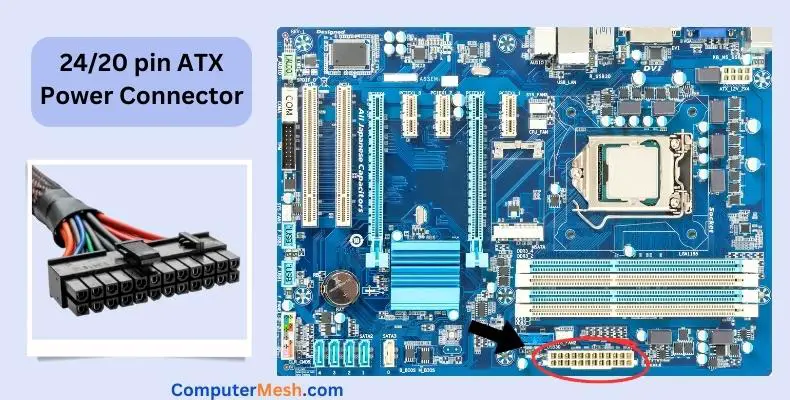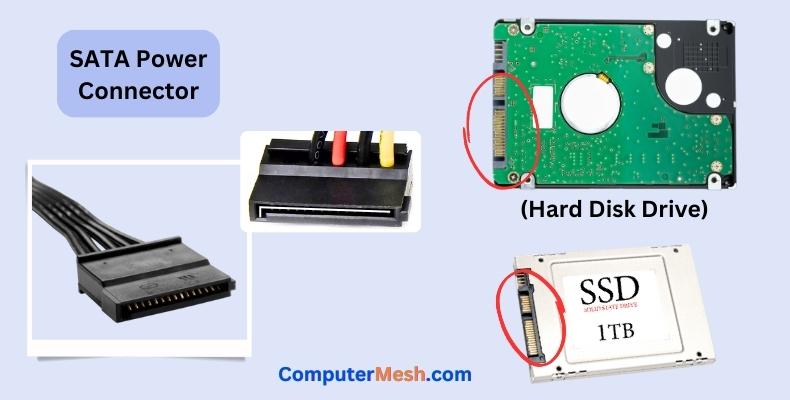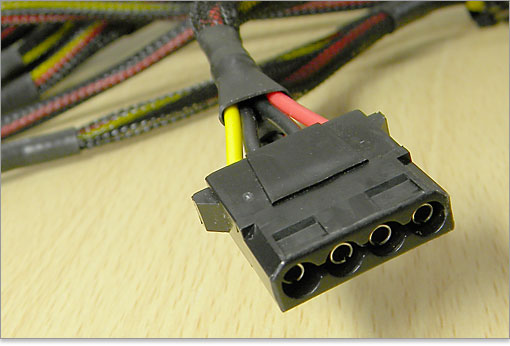Power Supply Connectors Guide – All Cables Use Explained.
Knowing the cables of the power supply and their correct placement is important. The fact is that each cable connector has a unique and different design to prevent plugging in the wrong connection, so it becomes necessary to understand how to connect each of the cables provided by the power supply to their right connection.
If you’re assembling a PC for the first time using a modular power supply, it’s common to feel overwhelmed by the number of connectors. Don’t worry; I am here to help you identify where the cable goes on the motherboard, storage, or GPU and to understand easily, explaining with pictures.
What types of Power Supply Connectors are there?
1. 24/20 pin ATX power connector – Plugs into Motherboard
This is the main power connector for the motherboard. It is wider and longer than other connectors of PSU as it is gathered as the thickest cable. Its purpose is to provide power to the component – the motherboard.

In the past, motherboards used a 20-pin connector for power, but now most use a 24-pin connector. However, some older motherboards still require the 20-pin connector, so newer power supply units may come with either a “24-pin” connector or a separate “20-pin + 4-pin” connector.
If you have an old motherboard compatibility (20 pins), you can use the separate type; in the case of a newer mobo, you will find 24 pins. So, to know which one to use, check the pin count on your motherboard.
2. 4 pin + 4 pin/8 pin 12V Power Connector – Plugs into Motherboard
A connector for connecting to the motherboard to power the CPU, its integrated graphics, memory controllers, and overall the VRM of the motherboard, which is different from the main 24-pin power connector.
Different manufacturers use different names given below, but it typically comes in either two 4-pin + 4-pin blocks or a single 8-pin configuration, which serves the same purpose.
- 4-pin ATX12V/8-pin EPS12V power connector
- EPS/ATX12V 8 (4 +4) pin power connector
- 4 + 4 pin ATX12V/EPS12V connector
- 4 pin + 4 pin CPU power connector
- CPU Auxiliary Power Connector

The 4-pin/8-pin 12V power connector has claws, so connect them correctly so that they engage with each other.
3. SATA Connector – Plugs into SSD & HDD
SATA Connector supplies power to SATA storage devices, SSDs, and HDDs. It provides three different voltage options – 3.3V, 5V, and 12V. Additionally, the connector has a unique design that is not symmetrical and looks like a lying down “L,” so it is important to look at the correct side for its installation.

If you have to use only one or two storage drives, it’s okay to use a power supply unit with fewer SATA power connectors. But if you want to mount a lot of HDDs or SSDs storage you need, or want to build a RAID, choose a power supply unit with many connectors, which can be more expensive.
Some PSUs have only 3 SATA power connectors, while others have up to 16, and the number of connectors generally increases with the unit’s height.
4. PCI-E Power Connector – Plugs into Graphic Card
Not to be confused with 8-pin CPU powering connector, despite their resemblance, both are different. PCI-E Power Connector, also known as ‘PCI Express auxiliary power connector,’ is used for supplying power directly to graphics cards with high power consumption but not low powered GPU like GT 730 or 1030 would not support connection.
So those graphics cards that consume more power from 75 to 150W, like RX 5500 and GTX 1080, use these connectors to receive additional power.

Initially, this connector type had six pins, but it is increasingly common to find it with up to eight, with greater transmission capacity. And there is a connector of “6 pin + 2 pin” configuration to correspond to both. The 6-pin can supply 75 W, and the 8-pin can supply 150 W.
While iGPU don’t need separate power supply like Intel UHD or Iris Xe as integrated with CPU chip.
5. 4-pin Peripheral Power Connector / Molex Connector
Peripheral connectors were the mainstream standard before SATA. It was used to connect hard drives based on the IDE data connector. But nowadays, HDDs with SATA connections instead, so IDE are rarely in use. If you have been using the IDE standard long, check it out.

If you have a spare peripheral connector, you can use it as a SATA power connector or case fan connector using a conversion adapter. Also it has been used for liquid cooling and RGB lighting as well, but SATA power connectors replaced them.
Precautions when using PSU connectors
Generally, connecting cables to a source is a simple and safe process. It’s commonly understood that the connector goes where it’s intended. However, inexperienced users often make common mistakes that should be avoided.
1. Distinguish between the 4-pin/8-pin 12V connector for Mobo and the PIC-E connector for GPU
CPU and graphics card cables are very easily confused since both are 8-pin, but in 99% of sources, the former are separated into 4+4 and the latter from 8-pin to 6+2.
- 4-pin/8-pin 12V power connector
- Separate to 4 pin + 4 pin
- connect to motherboard
- PCI-E power connector
- Separate from 8 pins to 6 pins + 2 pin
- connect to the graphic board
It is important to distinguish them correctly, and also refer to the manual before connecting to avoid making mistakes. Connector X does not go into Y, but some people might mistakenly assume it is the correct connector and forcefully try to connect it, breaking it and possibly causing damage to the equipment.
2. The orientation of the SATA connectors can cause the hard drive pin to break, so if you’re using a lot of force to make the connection, the orientation is probably wrong. Keep an eye out.
FAQs
What connectors are found on every desktop power supply?
Every desktop power supply generally has three primary connectors; a 24-pin main connector responsible for supplying the power to the motherboard, a 4/8 pin (ATX 12V) power connector that provides power to the processor and its integrated graphics and memory controllers, and third SATA power connector for the hard drives and SSDs.
What are pins conversion adapters or PCI Express adapters?
There are numerous types of adapters used to convert the connectors use of your power supply. For example, if your PSU doesn’t have eight-pin connectors, you can use six-to-eight-pin adapters. Similarly, if you want to use a more powerful graphics card but don’t have a PCI Express connector in your power supply, you can get a PCI Express adapter of good quality.
What is an FDD power connector?
The FDD connector, which has only 4 pins, is no longer available on modern power supplies. Used for floppy disk drives and built-in card slots (bay accessories). Due to its low output, it is not suitable for devices that require high output. Moreover, floppy disks are not used anymore, while it was also used as connector for different case fan sizes, they had limited use beyond that.
Why my GPU doesn't have any connection slot for PCIe connectors from PSU?
Most lower end GPUs don’t require PCIe power connectors from PSU as they get enough power from the motherboard to work properly. Only GPUs with high power requirements are required to connect with PCIe power connectors from PSU.
[Related]
